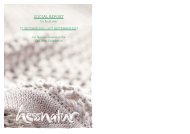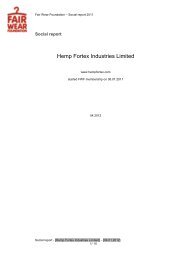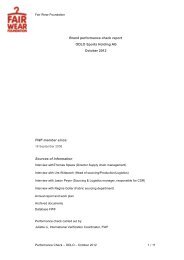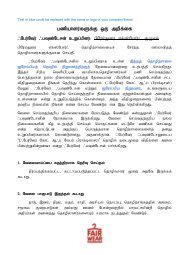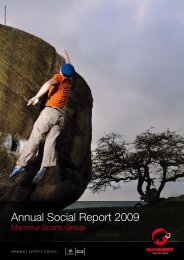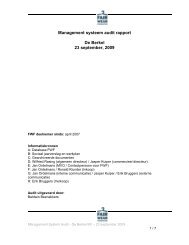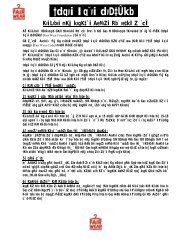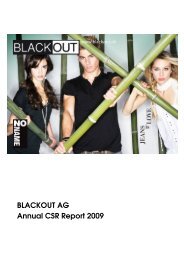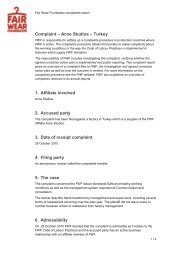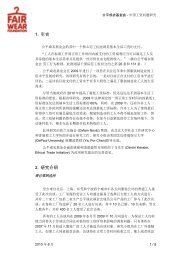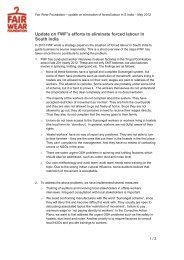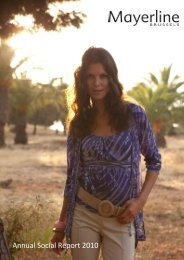Background Study Tirupur - Fair Wear Foundation
Background Study Tirupur - Fair Wear Foundation
Background Study Tirupur - Fair Wear Foundation
Create successful ePaper yourself
Turn your PDF publications into a flip-book with our unique Google optimized e-Paper software.
The manufacturers of circular knitting machines and dyeing machinery are mainly<br />
located in Punjab, specially in Ludhiana and Amritsar. With the introduction of<br />
new technology, imported machinery has been in widespread use in <strong>Tirupur</strong>. The<br />
commission agents and dealers for both indigenous and imported machinery are<br />
based in <strong>Tirupur</strong> providing access to the latest models available worldwide.<br />
Conducive to the need of the export market, innovative service enterprises have been set up<br />
by private entrepreneurs. These services are targeted at exporters, suppliers, manufacturers,<br />
buyers, importers and the retailers that help their customers to reduce their risk, improve efficiency,<br />
provide inputs for cost control, implement and ensure compliance of the mutually<br />
agreed quality systems.(IICCI:47)<br />
There is a noticeable absence of adequate capacity in good quality dyeing and finishing<br />
processes. These two processes limit the entry of Indian textiles into higher value added<br />
products despite a modern spinning sector.<br />
Furthermore, production run sizes are longer in Indian plants across the three processes ,<br />
resulting in higher waiting times for a lot and higher working process inventory. The average<br />
manufacturing and delivery lead times from procurement of yarn to shipment ( receipt by<br />
customer) for India’s apparel exports is between 144 to 182 days, which is often longer than<br />
an entire fashion season.<br />
The <strong>Tirupur</strong> industry also requires better quality and more competitive rates of hosiery yarn<br />
because in the knitting process, yarn has to be converted into loops and while a defect in<br />
woven fabric is rectifiable, a defect in knitted fabric is not rectifiable and yarn costs contribute<br />
to 60 per cent of the cost of the fabric.<br />
In the past few years, however, over 200 units have taken up to modernisation of their production<br />
processes with fresh investments. About 800 new knitting machines have been imported<br />
from abroad. According to the UNIDO report, soft flowing dyeing machines, compacting<br />
machines for minimising residual shrinkage, dyeing machines, computerised colour<br />
matching systems and stenter machines for removing deformity in knitwear are some of the<br />
many new machines that have been bought by the industry. IICCI:34<br />
Liberalisation of markets led to a shortage of yarn for <strong>Tirupur</strong> producers. Spinning mills preferred<br />
to export yarn, taking advantage from the high prices on the world market.<br />
2.5. Description of types of garment production<br />
Early in the 80s export of knitwear, mainly basic T-shirts were made in small quantities. Exports<br />
of other knitwear items gained momentum after 1985. In the late 80s the knitwear industry<br />
diversified very quickly and took up manufacture and export of other outer garments,<br />
viz, cardigans, jerseys, pullovers, ladies blouses, dresses and skirts, trousers, nightwear,<br />
sportswear etc.<br />
The knitwear industry in <strong>Tirupur</strong> has concentrated mainly on the production of garments for<br />
the spring and summer seasons. Of late, the industry has diversified its production range to<br />
include winter garments, using polar fleece and blended fabrics. At present, winter garments<br />
have come to hold a share of 20 per cent in the total production of knitwear in <strong>Tirupur</strong>. As<br />
cotton garments are meant for only the spring and summer seasons, which are short-lived in<br />
Europe and Western countries, the industry perforce has to take up production of winter<br />
garments which have year-round demand in international markets. (IICCI:44)<br />
Technologies used:<br />
Yarn manufacturing cone machines, winding machines, loom and spinning machines are<br />
used. Now modernized equipments are used in few mills. The knitting machines are locally<br />
called a Ludhiana machines based on its place of production. Padlock stitching machines,<br />
tailoring machines, cutting equipments, scissors, bleaching tanks, compacting machine, dyeing<br />
tanks, common effluent treatment plants, water tanks for washing, colouring plants,<br />
screen-printing boards, embroidery machines, computers for designing the fashion clothes<br />
7



